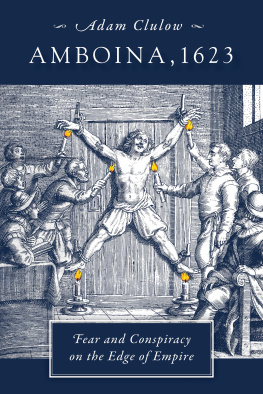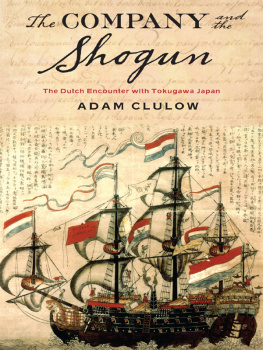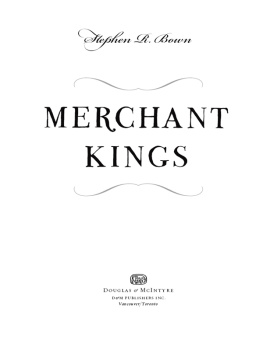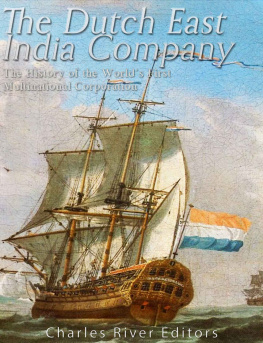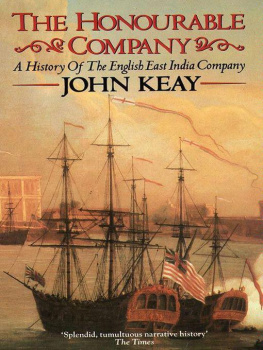AMBOINA, 1623
Amboina, 1623
FEAR AND CONSPIRACY ON THE EDGE OF EMPIRE
Adam Clulow
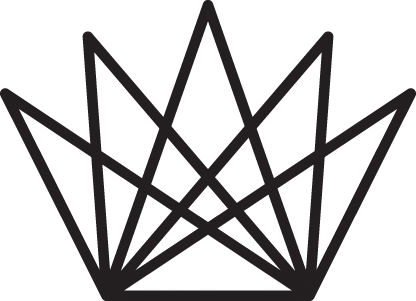
Columbia University Press
New York
Columbia University Press
Publishers Since 1893
New York Chichester, West Sussex
cup.columbia.edu
Copyright 2019 Columbia University Press
All rights reserved
E-ISBN 978-0-231-55037-6
Library of Congress Cataloging-in-Publication Data
Names: Clulow, Adam, author.
Title: Amboina, 1623 : fear and conspiracy on the edge of empire / Adam Clulow.
Description: New York : Columbia University Press, [2019] | Includes bibliographical references and index.
Identifiers: LCCN 2018058385 | ISBN 9780231175128 (cloth : alk. paper)
Subjects: LCSH: Ambon Island (Indonesia)History17th century. | Trials (Conspiracy)IndonesiaAmbon Island. | Nederlandsche Oost-Indische CompagnieHistory17th century. | East India CompanyHistory17th century. | Netherlands Foreign relationsGreat Britain. | Great BritainForeign relationsNetherlands.
Classification: LCC DS646.69.A43 C55 2019 | DDC 959.8/52dc23
LC record available at https:// lccn .loc .gov /2018058385
A Columbia University Press E-book.
CUP would be pleased to hear about your reading experience with this e-book at .
Cover design: Elliott S. Cairns
Cover art: The Most Savage and Horrible Cruelties Lately Practised by the Hollanders upon the English in the East Indies (Presborow, 1624). Nationaal Archief, The Hague, States General, 1.01.02, inv. no. 12551.62-3.
Contents
View of Ambon
Portrait of Jan Pieterszoon Coen
Nutmeg from the Banda Islands in 1599
The fort at Ambon
Map of Ambon and Hoamoal
The Japanese in Southeast Asia in 1600
Imagined illustration of waterboarding at Amboina in 1623
Copy of Shichizs signature
Copy of Sidney Miguels signature
Samuel Coulsons psalm book
Dutch translation of A True Relation of the Unjust, Cruell, and Barbarous Proceedings
Image depicting torture of the English
VOC senior merchant
The castle of Batavia
D utch East India Company sources make use of the Gregorian calendar, which was ten days ahead of the Julian calendar used by the English. To provide some uniformity in dates, I have wherever possible converted all dates found in English documents into the Gregorian calendar. There are significant inconsistencies in the names of Dutch East India Company ships and employees as they appear in the sources. In general, I have either maintained the original spelling or chosen the most common variant. As is standard in studies of this period, I have employed the shorthand Dutch and English to describe the two sides involved in the Amboina conflict, even while acknowledging that both companies drew from a far more expansive labor pool. Most studies in English of this case refer to it as the Amboyna trial. As this book draws more heavily on Dutch archives and scholarship, I have used the variant Amboina, which appears most commonly there. Across the early chapters of this book, I have made extensive use of an important compilation of Jan Pieterszoon Coens letters: H. T. Colenbrander and W. P. Coolhaas, eds., Jan Pietersz. Coen: Bescheiden Omtrent Zijn Bedrijf in Indi , 9 vols. (The Hague: Martinus Nijhoff, 19191954). To enable easier reference within this vast source, I have provided a brief description of the primary sender and recipient in the notes. These descriptions are intended to guide the reader but they are not comprehensive and do not include all of the individual senders or recipients.
I have worked on this book on and off for close to a decade and a half since 2004, when I first encountered the Amboina case during a research trip to the British Library. In that time, I have received invaluable help, support, and guidance from a wide range of people and institutions. Without them this book would never have been completed. My first debt is to Adam McKeown, a brilliant historian and remarkable teacher who died at a tragically young age while this book was being written. Adam was a mentor to me while I completed my doctoral dissertation at Columbia and he served from the day I met him as my model for what a teacher and scholar could be. He encouraged me to pursue this project and weighed in as I wrestled with endless early drafts. In his scholarship, his generosity, and his humanity, Adam was an inspiration to me and so many others, and he is sorely missed.
Over the past decade, I have presented different aspects of this project numerous times and have always emerged with fresh insights and ideas. David Lurie, my wonderful PhD supervisor, encouraged me to present this work at the Donald Keene Center at Columbia and pushed me to sharpen my views on the trial. If there is a single origin point for this project and so much of my research since, it is the first course I took with David, Japan Before 1600, which forever changed my trajectory as a scholar. I owe a special thanks to Lauren Benton, who invited me to present my work at Vanderbilt; Siyen Fei, who arranged for me to give a paper at the Annenberg Seminar series at the University of Pennsylvania; and Rusty Kelty, for a wonderful public event at the Art Gallery of South Australia. Many scholars gave generously of their time to read a series of ramshackle and imperfect drafts. Martine van Ittersum, the groundbreaking scholar of Grotius and the Dutch East India Company, read an entire draft of the manuscript and greatly improved it with her comments. I was privileged to host Dani Botsman, Lauren Benton, and Jan Lauwereyns in Melbourne on separate visits while I was finishing the manuscript, and all three shaped it in crucial ways.
I started work on this project as a PhD student at the Historiographical Institute at the University of Tokyo. There I am grateful to Matsui Yko and Matsukata Fuyuko for welcoming me into their remarkable research center. In Tokyo, I was privileged to work with the library left by Iwao Seiichi, the great chronicler of the Japanese in Southeast Asia, whose formidable work has continued to inspire me in the decades since I first read it. At Columbia, I am indebted to Carol Gluck, Henry Smith, and Greg Pflugfelder for all they did to support my research. Once I finished my PhD, I was fortunate enough to spend a year at Princeton University as part of the Fung Global Fellows Program while I worked on part of this project. There, Michael Laffan and Saarah Jappie generously aided me with the translation of a series of Malay documents, while Michael Gordin, Helder De Schutter, David Kiwuwa, Priti Mishra, Brigitte Rath, and Ying Ying Tan provided the company of an extraordinary group of scholars.
My first publication related to this project was in Itinerario in 2007, and I remain very grateful to the editors and anonymous readers for their help in guiding that article through to final publication. Jack Wills, another remarkable historian and towering figure in the field who also passed away recently, read drafts of the article and gave freely of his encyclopedic knowledge. Across the years since I started my PhD, Leonard Bluss, the great pioneer of studies of the Dutch East India Company in Asia, inspired me to always go back to the archives with fresh vigor while pushing me to sharpen the chapter on Japanese mercenaries.
The bulk of work on this project was completed at Monash University, where I have taught since 2008. When I arrived at Monash with the ink of my dissertation barely dry, I was fortunate enough to be placed in the office next to Ernest Koh, the most generous of all colleagues, who has provided a constant source of support and encouragement. I am grateful as well to numerous colleagues, including Clare Corbould (who read a crucial early draft), Seamus OHanlon, Noah Shenker, Daniella Doron, Carolyn James, Michael Hau, and Susie Protschky, as well as to three successive heads of schools, Al Thomson, Megan Cassidy-Welch, and Christina Twomey, for giving me the time and space to pursue this research. Three much esteemed and vastly generous senior colleagues, Bain Attwood, David Garrioch, and David Chandler, all read drafts of the full manuscript and contributed hundreds of suggestions and comments. I am also very grateful for the support provided by an Australian Research Council Discovery Early Career Research Award, which gave me time off teaching to complete this project.

